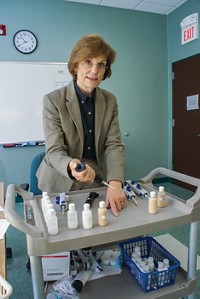Advertisement
Grab your lab coat. Let's get started
Welcome!
Welcome!
Create an account below to get 6 C&EN articles per month, receive newsletters and more - all free.
It seems this is your first time logging in online. Please enter the following information to continue.
As an ACS member you automatically get access to this site. All we need is few more details to create your reading experience.
Not you? Sign in with a different account.
Not you? Sign in with a different account.
ERROR 1
ERROR 1
ERROR 2
ERROR 2
ERROR 2
ERROR 2
ERROR 2
Password and Confirm password must match.
If you have an ACS member number, please enter it here so we can link this account to your membership. (optional)
ERROR 2
ACS values your privacy. By submitting your information, you are gaining access to C&EN and subscribing to our weekly newsletter. We use the information you provide to make your reading experience better, and we will never sell your data to third party members.
Environment
In Praise Of The Nose
Fragrance designer Michael Papas philosophizes about perfumes and reveals what goes into them
by Ivan Amato
April 24, 2006
| A version of this story appeared in
Volume 84, Issue 17

Spend a few hours with Master Fragrance Designer Michael Papas, and you will leave knowing that his father used to wear Old Spice and his mother used to favor the perfume Vanilla Fields. You will know that his seven-year-old daughter once abhorred taking showers but now loves to take them because of shampoos that smell like grapes and pineapple. As he informs you about these personal facts of his life, he also will show you what it takes to become more than the amateur smellers most of us are.
At last month's national meeting of the American Chemical Society in Atlanta, Papas-who looks like he could be a cousin of Billy Joel's and speaks with an accent that would fit gracefully into any episode of "The Sopranos" (minus the profanities)-put on what can only be described as a four-hour fragrance design and philosophy performance. Home base for him is Quest International Fragrances' branch in Mount Olive, N.J.
With the help of dozens of paper test strips labeled "raspberry," "rose," "herbal," "aldehyde," "vanilla," "lavender," "marine/ozone," "bergamot," "patchouli," "nutmeg," "cinnamon," "ginger," "musk," and "sandalwood," among others, participants of this workshop-style presentation in the Division of Chemical Technicians' program got delightful whiffs of the aroma chemicals that designers combine in just the right proportions to create fragrances that can spin human emotions in specific directions.
"From the time you get up in the morning to the time you go to sleep, smell is there," Papas reminded his audience, ticking off the toothpaste, soap, mouthwash, shaving cream, deodorant, breakfast, lunch, dinner, grass, leather, and myriad other odiferous items encountered during a typical day. What you smell is just the sensory side of the fragrance experience. Says Papas: "Emotionally, you are experiencing positive or negative responses."

Consider the fragrance-induced experience Papas had the morning of his ACS presentation. It turned out that the shower in his hotel room didn't work. To compensate, Papas admitted, he was perhaps a little more liberal than usual in the application of his Old Spice deodorant. For Papas, Old Spice fragrance is a powerful reminder of his father, who passed away some years ago. "I put it on, and I am so connected to him," Papas told his audience. It is that evocation of an emotive and cognitive experience that fragrance designers aim for as they mix and match the aroma chemicals they have at hand, Papas says.
Consider your doctor's office. Some physicians' offices use "vanilla plug-ins," fragrance-releasing devices that rely on gentle electrical heating to volatilize the fragrance. "People get nervous in doctors' offices," Papas says. "Vanilla is very comforting."
Another example of a fragrance that has been designed to evoke a specific feeling is the Bobbi Brown perfume Beach, Papas noted. It smells like Coppertone sunscreen. That might not seem like a smell you would naturally choose for a perfume, Papas said, but "it's going for the feel of vacation. The emotive power of smell is important."
Another nonintuitive approach Papas himself has been playing with in recent fragrance design projects has to do with dirt. "When people smell dirt, they love it," Papas said, drawing on consumer tests of potential new dirt aromas, or "notes," he has been working on. "They describe a dirt note as fresh, like a gardening smell. Dirt is clean to them." For example, two key notes here, cis-3-hexen-1-ol and ligustral (6-isobutylquinoline), elicit thoughts of crushed leaves and cut grass, respectively. On the cognitive level, these aroma chemicals "can bring the outdoors into the house," Papas said.
The concept of "new-car smell" is one that Papas also has been revisiting. To him, a new-car smell shouldn't try to replicate the new-leather or vinyl smell of a car when it is just purchased. "I wash the car on the weekends, shampoo the rug, clean the dashboard," Papas said. "My car smells new after that. This is what I think people want, not leather."
Most fragrances, whether they are the basis of fine perfumes or inexpensive scented candles, comprise three classes of aroma chemicals, often referred to as top, middle, and base notes. Top notes, among them citrus aromas such as lemon, mandarin, and bergamot, are the most volatile components. They are the ones that hit you in the face when you open the package of a scented product, and they're mostly gone in about 20 minutes. Middle notes, including spicy, weedy, and leathery smells—among them eucalyptus, pine, menthol, rosemary, and sage—emanate over the course of a few hours. All the while, they mingle with the powdery, animally base notes, including musk, amber, cedar, and vetiver, derived from a tall Pacific Rim grass. In fragrances, base notes are the ones that last longest, sometimes all day. In all, fragrances can contain dozens of specific aroma chemicals.
A fragrance designer also has to consider the mode of delivery. Compared with perfumes applied as liquids, for example, aerosol products and candles have less of a need for volatile, top-note aroma chemicals. In these cases, aerosolization and heat provide physical assistance for getting the aroma chemicals into the air. Fragrances for products like these, then, are often heavy on the middle notes.

The smell of the aroma chemicals themselves, whether extracted and isolated from natural sources or synthesized, is but one of the many factors that perfumers must weave into an affordable commercial balance. Among these are stability, pH, solubility, viscosity, foaming properties, the physical phase of the products, precipitation behavior, interactions with packaging materials, social and marketing trends, costs, and cultural differences in responding to smells.
"Safety is kicking in big time," Papas added, referring primarily to the growing concern about toxic ingredients in products. Perhaps reflecting that reality was the presence in the audience of three employees from the National Institute of Occupational Safety & Health. One of them insisted to C&EN, however, that he and his colleagues were attending Papas' talk not to find opportunities for imposing new regulations but to learn more about how the fragrance industry works.
In the end, Papas said, "you can have great scientific data, but human perception is more important." The equation by which fragrances win or lose is so complex that Papas often relies on his own gut feelings for making decisions. "More people should use their gut-feel," he told his audience, opining that too many people forget that they are expert at making judgments and instead defer to so-called professionals.
One of Papas' home runs as a fragrance designer emerged from a request by one of his primary clients, S.C. Johnson & Son of Racine, Wis., for a fragrance that captures the "extreme freshness of clean sheets drying outdoors in the brilliant sunshine." Over a four-month period a few years ago, he concocted a half-dozen "accords," which are small ensembles of top, middle, and base aroma notes. They have names like "airy accord," "transparent floral accord," "clean accord," and "citrus accord." Then, with the help of consumer focus groups, he found a combination of these accords that has been trademarked as Clean Linen. Of the 20 or so Glade candle products that S.C. Johnson sells, the one with the clean linen scent is selling best, according to John J. Conlon of S.C. Johnson's Air Care division.
An even newer candle fragrance that Papas created for S.C. Johnson, Café Latte, required research that included many hours in coffee shops. The goal was to create a fragrance that evokes the comfortable, lazy, untroubled feeling of sitting in a coffee house and treating yourself to pastries and some java. What came of this effort is a two-pronged candle fragrance that mixes a coffee fragrance with one reminiscent of pound cake. "This is more than just coffee," Papas said. "It's the coffee house experience."
A measure of great success for a fragrance is when it takes on an iconic and positive meaning in a culture. "Pine Sol smells like a janitor," Papas noted, adding that it smells nothing like natural pine. "But people want it. ... It's a functional odor that smells like 'clean.' " A smell like that, Papas said, "you just don't mess with."





Join the conversation
Contact the reporter
Submit a Letter to the Editor for publication
Engage with us on Twitter